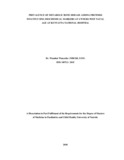| dc.description.abstract | Background
Over the past 20 years, there has been an increase in the survival of infants born
prematurely as a result of better newborn care and facilities. Preterms are at increased
risk of various problems including metabolic bone disease.
Metabolic bone disease (MBD) of prematurity has been defined as a decrease in the
bone mineral content relative to the expected level of mineralization for a fetus or infant
of a similar size or gestational age plus biochemical and/or radiographic (1). Preterm
neonates are predisposed to MBD of prematurity as they fail to accumulate the essential
minerals, namely calcium and phosphorus, required for bone growth that are transferred
from the mother to fetus in the last trimester. Children who develop MBD are at risk of
poor growth and weight gain, prolonged need for ventilation and as a consequence
delayed hospital discharge and risk of rickets of prematurity later on in life. MBD may
go undetected as significant demineralization has to occur before it is clinically evident.
Screening for MBD is therefore essential early in the course of disease and can be done
by assessing bone biochemical markers such as alkaline phosphatase, serum calcium
and phosphorus levels.
Study Objective
To determine the prevalence of metabolic bone disease of prematurity, using
biochemical markers, at 6 weeks post-natal age at Kenyatta National Hospital.
Methodology
This was a cross sectional study conducted at Kenyatta National Hospital, newborn unit
and outpatient department.
Preterm neonates between 28 weeks and 34 weeks gestation and a birth weight between
1,000 g and 2,000 g, feeding on mother’s own milk, were recruited. Anthropometric
measurements were taken after birth. The patients were followed up and at 6 weeks of
age and their biochemical markers analyzed. These bone biochemical markers included
serum Alkaline Phosphatase (ALP), calcium and phosphorus levels. Anthropometric
measurements were taken again at 6 weeks post-natal age. Risk factors were retrieved
from the patients' files. The risk factors assessed included feeding history, medication
history and co- morbid conditions.
xii
Results
Eighty two neonates were screened for MBD at 6 weeks of life with 46.3% being male
while 53.7% were female. The mean gestational age and birth weight was 31.5 weeks
(SD 1.8) and 1587.3 g (SD 254) respectively. Of the growth parameters at birth, the
mean head circumference was 30 cm (SD 1.6) and the mean length was 39.9 cm (SD
2.56). At 6 weeks, the mean weight increment was 15.9g/day (SD 8.9), length was
0.4cm/week (SD 0.2) and head circumference was 0.4cm/week (SD 0.6). The median
day for initiation of feeds was day 4 (IQR 3-4) while the median day for reaching full
feeds was day 10 (IQR 8-14).
There was no association found between neonatal sepsis, neonatal jaundice, necrotizing
enterocolitis, respiratory distress, asphyxia and MBD (p>0.05). Of the neonates
screened, 49% were found to have hypophosphatemia while 4.8% had hypocalcemia.
The prevalence of MBD was found to be 17% (95% C.I 11-28%).
Conclusions
The prevalence of MBD of preterms was high at 17% in KNH. There was no significant
association between feeding practices, medications used and certain co- morbid
conditions with MBD.
Recommendations
Screening of preterms gestational age less and equal to 34 weeks and less than 2000g
from 6 weeks post-natal age. | en_US |
| dc.description.department | a
Department of Psychiatry, University of Nairobi, ; bDepartment of Mental Health, School of Medicine,
Moi University, Eldoret, Kenya | |



